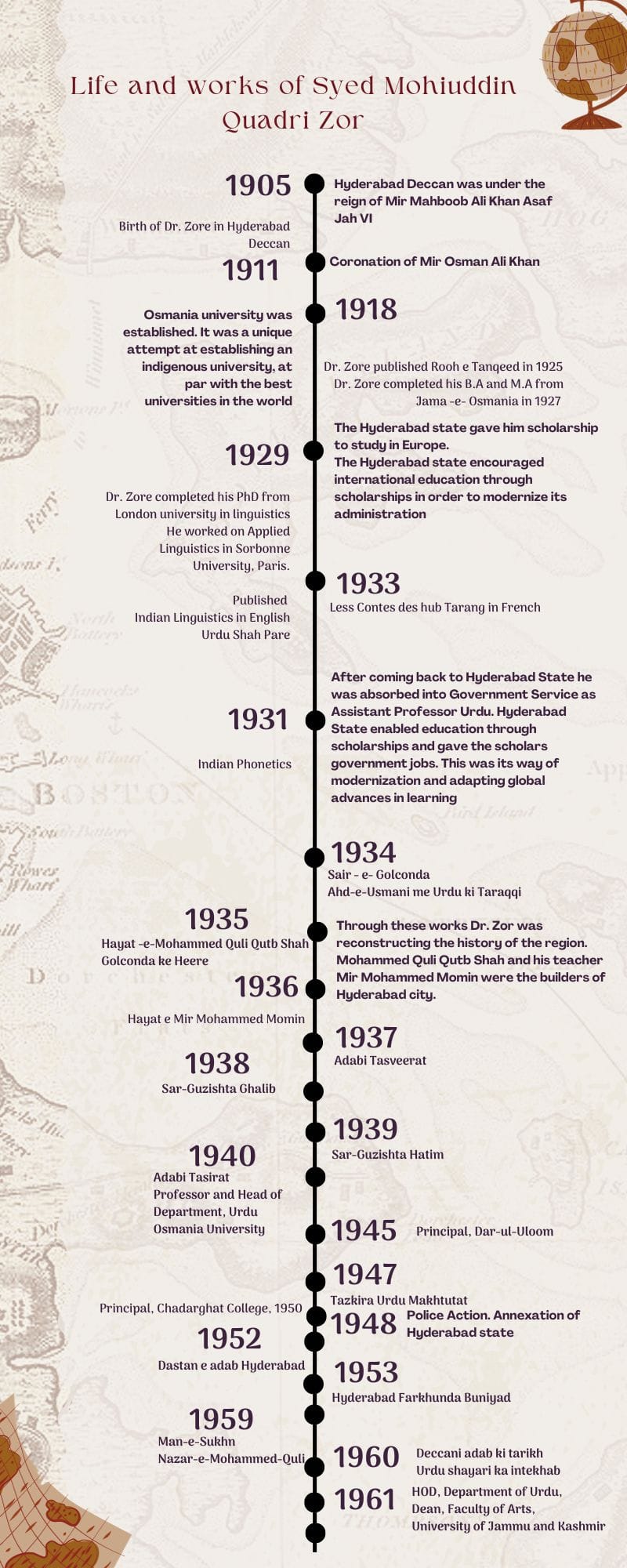Works of Zor Sahb
The collection is based on the work of Dr. Syed Mohiuddin Quadri Zor.

Rooh e Tanqeed: Published in 1925, this book is a treatise on Urdu literary criticism. It explores the aims, history, and methods of criticism in Urdu literature.
Hindustani Sutiyat: Published in 1929, it is a work on Indian phonetics. It is currently digitally unavailable.
Hindustani Lisaniyat: Published in 1931, it is one of the earliest works in linguistics from the Indian subcontinent. It has a special focus on Urdu. This was based on Dr. Zor’s PhD work.
Les Contes De Hub Tarang: This was published in 1933 from Paris. It was a Mansavi of Miyan Hub Mohammed Cisti of Ahmedabad.
Urdu Shah Pare: Published in 1929 from Hyderabad, this book presents a brief history of Urdu literature in the Indian subcontinent. It has sections on Urdu literature in Bijapur, Golconda and under the Mughal sultanate.
Urdu ke Asaleeb Bayan: Published in 1927, the book examines a long history of Urdu publishing.
Tanqeed e Maqalat: The book examines a brief history of Urdu literature and literary criticism. It also discusses various rules of criticism.
Garsan Datasi: Published in 1932, this book discussed the work of Joseph Heliodore Garcin De Tassy, a19th century Indologist, who devoted himself to the study of Hindustani (Urdu). It was an elaborate account of De Tassy’s methods, findings, influences, students, and lineage of his work.
Sultan Mahmood Ghaznavi ki Bazm e Adab: Published in 1928, this book looks at the history of Abbasid dynasty, its patronage to Persian literature with a specific focus on literature during Mahmood Ghaznavi.
Ahd-e-Usmani me Urdu ki Taraqqi: Published in 1930, the book examines the patronage for Urdu language in Asaf Jahi dynasty and the birth of Osmania University. Jam-e-Usmania, was the pinnacle of modernist development of Urdu. It aimed to develop Urdu as a language of science, an indigenous answer to European dominance in science. Refer to Kavita Datla’s work The Language of Secular Islam: Urdu nationalism and colonial India for detailed history of Osmania University.
Sultan Mohammed Quli Qutub Shah: Mohammed Quli Qutub Shah (1565-1612), the Sultan of Qutub Shahi Dynasty, is said to be the first Urdu poet to have full divan. He was also the founder of the city of Hyderabad and is said to be adept at Telugu poetry. The Qutub Shahi dynasty was known for its syncretism. Thus, the figure of Mohammed Quli Qutub Shah, was important for Dr. Zor from the perspective of history of Urdu language, history of the region, and for the value of religious pluralism. This book examined the history of Qutub Shahi dynasty and Sultan Mohammed Quli Qutub Shah. The focus on Urdu language, the Deccan region and religious pluralism is also seen in the later work of Dr. Zor.
He published another book by name Hayat a Mohammed Quli Qutub Shah in 1930 which is currently unavailable in digital form.
Hayat e Mir Mohammed Momin: Mir Mohammed Momin was the architect of Hyderabad. He had migrated from Iran and had gained prominence in the Deccan. He designed Hyderabad based on Persian cities. Kevin B. Haynes argues that Hyderabad was based on Isfahan of Iran, it was known as Isfahan -e -Nau. This book was also a part of the Dr. Zor’s efforts to build the history of the region. It was the earliest history of Mir Momin. See Keelan Overton’s Iran and the Deccan for discussion on Mir Momin.
Fan-e-inshapardazi: Published in 1932, this book is a treatise on essay writing in Urdu. It discusses why, what, and how of writing essays.
Sair-e-Golconda: First published in 1934, this book told the legends of Hyderabad Deccan. The book was widely popular and ran into many editions. Along with meticulous research on history of the language and region, this book illustrates the significance of stories and myths that build a region.
Golconda ke Heere: This book has the myths, legends, and stories of Golconda.
Tilism-e-taqdeer: A treatise on literature, and literary criticism
Dastan-e-adab-e-Hyderabad: It narrates the three-hundred-year history of Urdu, Persian, and Arabic literature of Hyderabad. It lists out all the poets and litterateurs of the region.
Tazkira Urdu Makhtutat: Reference of Urdu manuscripts
Farkhunda Buniyad Hyderabad: This book discusses the history and culture of Hyderabad by giving brief history of various monuments and places in the city.
Adabi Tasveerat: Book is not available.
Sarguzisht-e-Ghalib: Brief history and work of Mirza Ghalib, one of the most important Urdu poets of the sub-continent.
Sarguzishta Hatim: Brief history and work of the poet Hatim.
Nazr-e-Mohammed- Quli Qutb Shah: Dr. Zor started the celebration of birth anniversary of Mohammed Quli Qutb Shah the founder of the city and the poet who wrote the first ever Urdu divan. This book was published on the event of Yom e Mohammed Quli, documenting the event and discussing the importance of Quli Qutb Shah to the city.
Deccani adab ki Tareekh: The book discusses the history of Deccani literature in Bahamani Sultanate, Adil Shahi Sultanate, Qutub Shahi Dynasty, Asaf Jahi Dynasty – Hyderabad and Aurangabad and the influence of Deccani literature on Hindustani Urdu.
Urdu shayari ka intekhab: This was a selection of Urdu poetry published by Sahitya Academy.
Source of the list of the books and date of publishing: Chand saksiyatein, chand tasirat by Moinuddin Ahmed Ansari, published by Urdu Academy, Sindh, Karachi.
